1959 Dutch Grand Prix race report: Bonnier makes his mark
Jo Bonnier claims his debut win and first for a Swedish driver; also first win for BRM almost a decade after it first entered Grand Prix racing
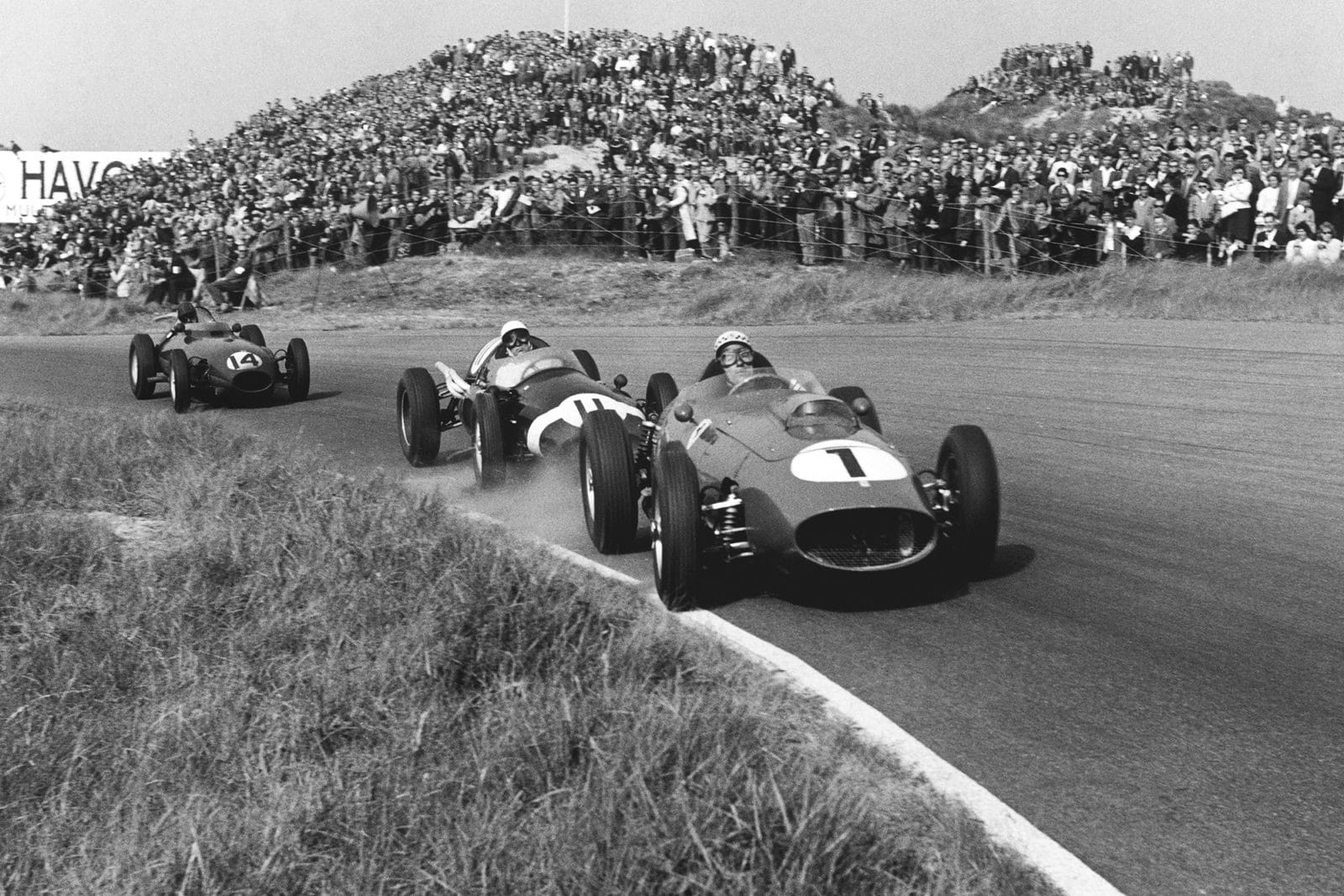
Jean Behra in a Ferrari Dino 246 leads Stirling Moss in a Cooper T51-Climax, and Graham Hill in his Lotus 16-Climax
© LAT Photographic
Before the Dutch Grand Prix began there was considerable activity on the Zandvoort circuit in the way of testing and experiments, for being a permanent closed circuit it is available at all times. A week before the race BRM were there with a car and the Dunlop engineers and, using Moss as the driver, 105 laps were covered at very high speed to give the disc brakes a thorough testing. The car proved admirably suited to the circuit and Moss lapped in times that were a considerable improvement on the existing record. Then during the week of the race the Walker team were there with a Cooper-Climax and Moss again drove a great many laps and nearly equalled his times with the BRM. On the day before practice began the Lotus team arrived and Graham Hill proceeded to try the cars and get them sorted out in readiness for the race.
Qualifying
The official practice began on Friday afternoon at 4:30pm, and though it was sunny there was a strong wind blowing head-on along the straight and everyone turned out, with Ferrari, BRM and Cooper having spare cars for training. Ferrari had as drivers Behra, Brooks, Hill and Allison and were hoping to get a last minute entry for their fourth car, while BRM and Cooper were limited to two entries each even though McLaren was there and a Cooper was available.
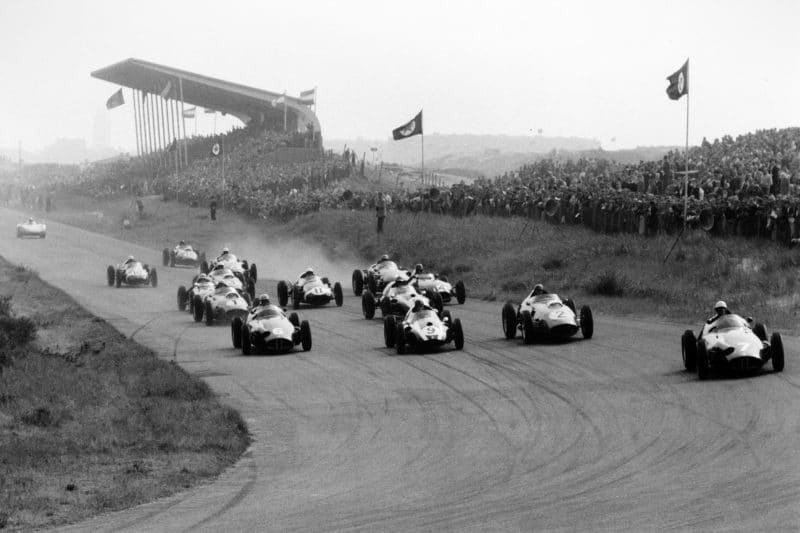
The pack leaves the start line – Jo Bonnier, BRM P25, leads Harry Schell, BRM P25, Masten Gregory, Cooper T51-Climax, Tony Brooks, Ferrari Dino 246, Jack Brabham, Cooper T51-Climax, Jean Behra, Ferrari Dino 246, Graham Hill, Lotus 16-Climax and Stirling Moss, Cooper T51-Climax. Carel Godin de Beaufort’s Porsche RSK is barely off the line
© LAT Photographic
The Dutch organisers felt there were enough green cars in the entry and gave the 14th position to their own driver de Beaufort with his 1,500cc Porsche, which caused many rude words. The two BRMs were first away, with Schell and Bonnier driving, while the Walker-Coopers were being started by a portable electric starter and a shaft inserted in the end of the gearbox. Behra was driving the Formula 2 Ferrari fitted with a large carburetter experimental engine but for a long time it was reluctant to start, in spite of being pushed vigorously up and down the pit area.
“The Dutch organisers felt there were enough green cars in the entry and gave the 14th position to their own driver de Beaufort with his 1,500cc Porsche, which caused many rude words”
The Zandvoort circuit is very smooth and not difficult to learn and it was not long before drivers were beginning to try fairly hard and Graham Hill was noticeably fast in the Lotus, the little car seeming to float round the fast bends almost on a neutral steer, and looking remarkably steady and safe. Ireland was driving the second works Lotus and looking very much at home on his first outing in a European Grand Prix and altogether the Lotus team appeared to have got themselves sorted out from their previous shambles.
Bonnier was driving hard and the BRM looked and sounded very much suited to the circuit, while the two Aston Martins of Salvadori and Shelby were not fast enough to get into handling difficulties compared with the other cars and did not have the acceleration of their rivals. Whereas the Lotus would float round a fast corner, leaning heavily on the outside wheel, the Coopers were also going fast but had both rear wheels leaning away from the corner at a frightening angle; Brabham seemed to be taking quite a time to settle into the circuit, whereas Gregory was trying hard quite early on.
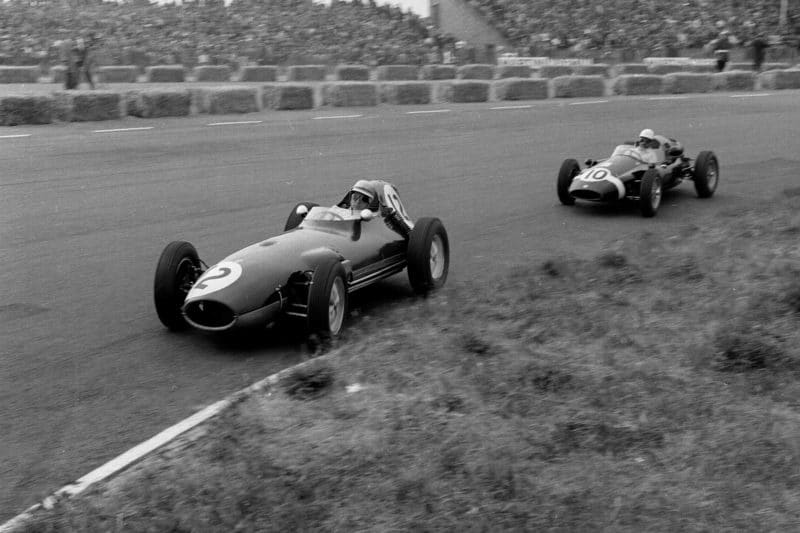
Tony Brooks driving a Ferrari Dino 24 leads Maurice Trintignant in his Cooper T51-Climax.
© LAT Photographic
None of the Ferrari team looked happy, Behra trying the experimental car and the spare Formula 1 car, while neither Brooks nor Phil Hill seemed at home or confident of the way their cars handled, Brooks looking as though he did not want to get the car sliding and Hill getting his car into sudden little twitches before he was really into the corners. Behra decided to stick to the Formula 2 chassis, so Allison took over the spare car but with no real idea of starting in the race but merely getting Grand Prix car experience.
As was to be expected after so much unofficial training Moss was incredibly fast with the Cooper-Climax and was going at such a speed round the back swerves that it was beginning to look dangerous, even for Moss. However, his handling of the little rear-engined car was quite remarkable and he was soon making very fast times, but he had to keep an eye on the BRM team as Bonnier was driving incredibly smoothly and quickly at the same time; Schell was working hard but not getting anywhere near his team mate. Trintignant on the second Walker-Cooper was not going as fast as the Aston Martins and then had a shaft in his gearbox break so his practice was ended, and before the two hours was over Moss did a few laps in de Beaufort’s RSK Porsche, and Graham Hill tried Ireland’s Lotus.
Apart from the Ferrari team everyone seemed pretty happy, and the order of fastest times was Moss with 1min 36.8sec, Bonnier 1min 37.6sec, Brooks 1min 38.0sec and Behra, Brabham and Ireland tying with 1min 38.4sec, though in fact the Lotus time was put up by Graham Hill. In spite of Brooks being third fastest, the Ferrari drivers were convinced their cars were not handling properly, though there seemed to be quite a difference of opinion as to exactly what they considered to be good handling!
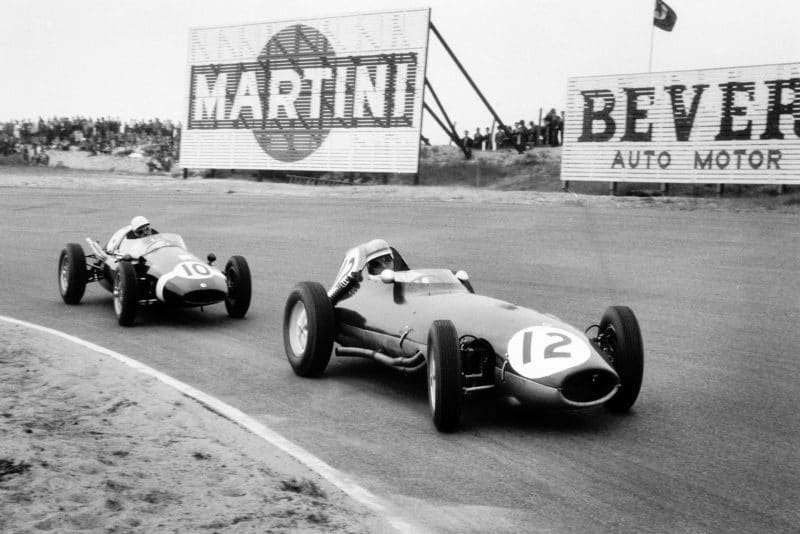
Innes Ireland driving a Lotus 16-Climax leads Maurice Trintignant at the wheel of a Cooper T51-Climax.
© LAT Photographic
The next day practice took place in the morning under similar sunny and windy conditions and everyone was out again except Trintignant and Allison. The Walker-Cooper was still having some new parts put in its gearbox and Ferrari had done a shuffle with their engines and chassis and the fourth car was not completed. Behra was still sticking to the F2 chassis but the experimental engine had been removed and replaced by one of the smaller carburetter Type 246 engines, the new one being put into the third F1 chassis, and it was this that Allison was waiting for.
Brabham was trying the brand new Cooper and Gregory was having trouble with his car jumping out of gear so John Cooper got Brabham to try the car, to check on the American’s complaint and try and find the reason. It did not take the knowledgeable Australian long to trace the trouble to faulty selectors not engaging the gear dogs completely, and as this could not be cured easily Gregory went out in the spare car.
Moss was still practising very fast and was getting worried about tyre wear, while BRMs were also chasing the Dunlop technicians about the wear on their left rear tyres. As a precaution they were practising pit stops and changing the left rear wheel, and getting their drivers accustomed to stopping at the right place. They were effecting these changes for both Bonnier and Schell in just under 30sec, using raw-hide hammers on the alloy hub caps, but reckoned to reduce this to nearer 20sec on race day using copper-hammers, there being no point in risking damage to the hub caps during practice.
The Walker team were in a difficult position for their fast Cooper was fitted with bolt-on wheels and a quick change was out of the question, and though they were using 7.00 by 15in rear tyres, the rate of wear was rather high. The two BRMs were using 15in wheels with 7.00in section tyres, in place of their usual 16in, wheels, and this was partly the cause of the tyre wear, but the handling was so vastly improved with the smaller diameter tyre that both drivers were prepared to risk a pit stop.
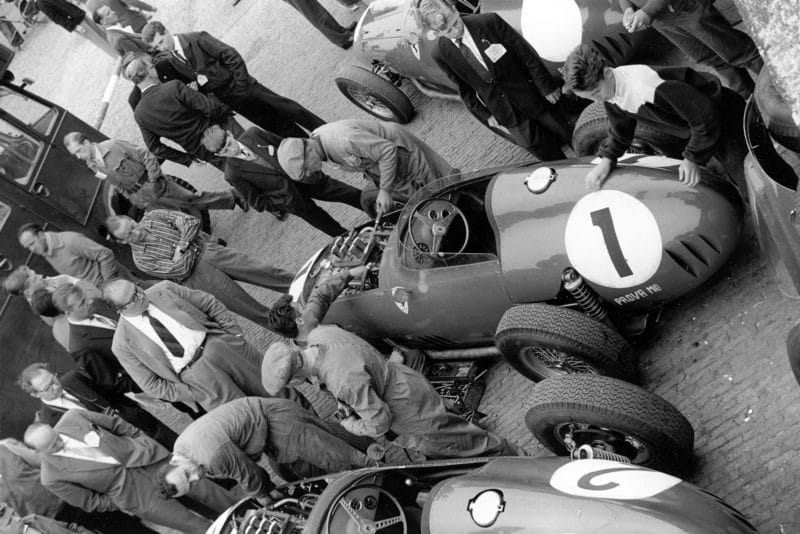
In the paddock Carlo Chiti (glasses, centre) overseas mechanics working on the Ferrari Dino 246 of Jean Behra.
© LAT Photographic
The pace of the previous practice was soon stirred up again by Moss when he improved on his previous best time of 1min 36.8sec with a lap in 1min 36.3sec and then did 1min 36.2sec. Graham Hill was going remarkably quickly and looking very safe and was approaching the 1min 37sec mark, while Brabham was equally as quick, and Behra got the F2/F1 Ferrari round in 1min 37.0sec and then did 1min 36.6sec, though Brooks and Hill were having difficulty in getting below 1min 40sec, neither of them being happy with their cars and not being allowed to try Behra’s car.
Lotus were really getting on with the job and the two works cars were going very well and even the Ferrari team looked a bit sideways when Graham Hill put in a lap at 1min 36.7sec and Ireland did 1min 38.3sec; then everyone came up all standing when Bonnier went out with the BRM and did 1min 36.0sec dead, so that now anyone not well under 1min 40sec was getting left far behind.
“Shelby was the fastest of the two Aston Martins with 1min 38.5sec, but the cars seemed too cumbersome and heavy to cope with the little cars”
Shelby was the fastest of the two Aston Martins with 1min 38.5sec, but the cars seemed too cumbersome and heavy to cope with the little cars, though they looked steady and reliable enough. Before practice finished for lunch Schell went out to try and get near Bonnier’a time but the best he could do was 1min 37.3sec which left him sixth fastest, and Graham Hill did some laps in Ireland’s car to investigate a locking front brake.
In the middle of the afternoon, practice restarted for another two hours and the wind changed slightly but many people did not bother to turn out, Aston Martins being satisfied that they could not go any faster, BRMs having gone more than fast enough and Moss being content with being on the front row of the start. In complete contrast the Ferrari team were still chaotic, or at least Brooks and Hill were with the F1 cars and the whole afternoon was spent trying different rear springs, changing shock-absorbers, checking tyre pressures and so on, with very little improvement and what suited Brooks did not suit Hill and vice-versa and they juggled with with the three F1 cars trying to come to some compromise on any two of them, but Behra did not help much by trying the spare car and saying there was not much wrong with it anyway! He was all right as he was going to race the shorter and lighter F2 chassis.
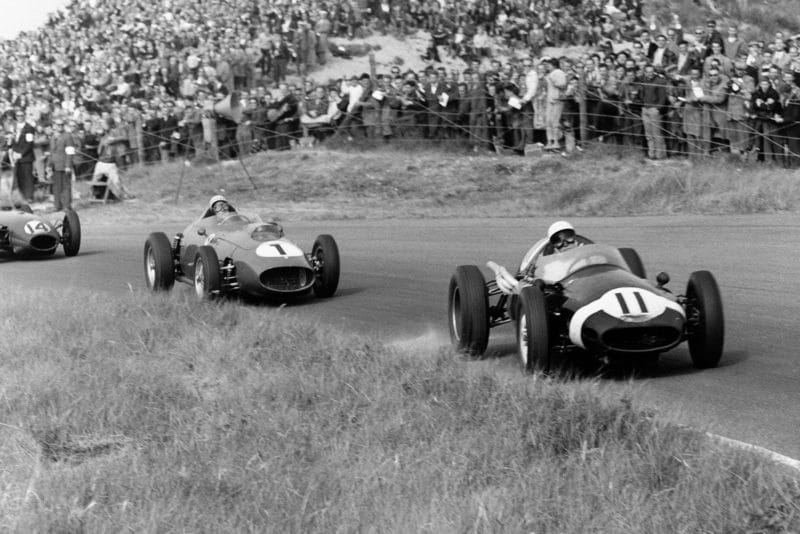
Stirling Moss driving the Cooper T51-Climax leads Jean Behra in his Ferrari Dino 246 and Graham Hill in a Lotus 16-Climax.
© LAT Photographic
Lotus had one car out doing final detail work and Coopers were sorting out the carburation on their new car, while Gregory was putting in some pretty steady practice, but not proving anything like as quick as Brabham. The Australian was busy working on the carburation of the new car himself and after each adjustment he went quicker than ever, getting down from a time of 1min 37.1sec to 1min 36.3sec and then 1min 36.0sec, equal to Bonnier’s morning FTD and at that he grinned contentedly and reckoned he had got things pretty well sorted out. Apart from the Ferrari team the rest were practically ready to race before this final session came to an end, and when the best times for the three days were totalled up it was found that all but de Beaufort with his sports Porsche had got below 1min 40sec, and there were only seven-tenths of a second covering the first five cars.
Sunday was still dry and sunny as a huge crowd swarmed into the circuit, covering the sand dunes like ants, and about an hour before the start was due the Ferrari team manager was collecting signatures from the other team managers and owners to plead for Allison to be allowed to start on the fourth Ferrari, to try and help combat the horde of green cars. This was finally agreed to and Allison was presented with the spare F1 car fitted with the large carburetter engine, which he had not driven before and was told to go quietly round and aim to finish.
Before the cars were lined up on the grid a row of 190SL Mercedes-Benz made a lap, each with a racing driver in the passenger seat, and then the serious business of motor racing began to take over, interrupted only briefly for the arrival of Prince Bernhardt of the Netherlands driving his own 250 GT Ferrari. Most of the teams were a little anxious over tyre wear and were starting their cars on brand new unscrubbed tyres, so that with full petrol tanks the drivers were planning to take things easy at the start while the BRMs were still on 15in wheels and were taking a chance on a tyre stop. The small but select starting grid was as follows:
See table representing grid formation.
Race
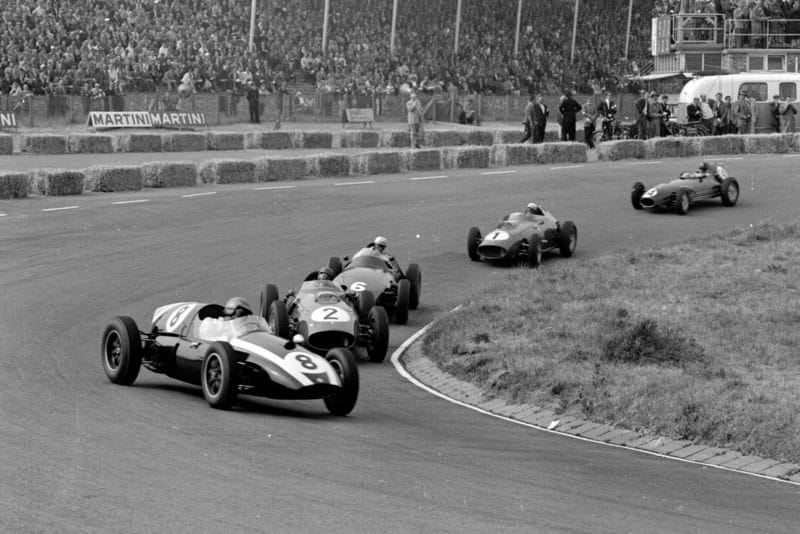
Jack Brabham driving a Cooper T51-Climax leads Tony Brooks’ Ferrari Dino 246 and Harry Schell’s BRM P25.
© LAT Photographic
As the flag was raised everyone began to creep slightly and when it fell Gregory shot from the third row into second place behind Bonnier, while Moss hesitated slightly and was instantly hemmed in on all sides as the pack accelerated away to the first corner. At the end of the opening lap Bonnier and Gregory were nose to tail and had already drawn away from the rest of the field which came by in the order Brooks, Schell, Brabham, Behra, Graham Hill, Moss, Ireland, Phil Hill, Trintignant, Shelby and Salvadori, as quick as that.
“At the hairpin at the end of the finishing straight there were cars three and four abreast, with Moss somewhere in the middle of it all”
On the swerves behind the pits Gregory got past Bonnier and later Brabham got past Schell, and after two laps Cooper led BRM, driven by an American and a Swede, and so soon they had nearly half the length of the straight lead over a pack of ten cars all running nose to tail with Brooks just leading Brabham, and into the wide hairpin at the end of the finishing straight there were cars three and four abreast, with Moss somewhere in the middle of it all.
Already the leaders were lapping at under 1min 40sec, so that any ideas of taking things easy were put to one side and by lap four Gregory and Bonnier had the length of the straight lead over Brabham who had shaken himself free of the storming mob and pulled out quite a lead. The scrap for fourth place was wonderful, Brooks, Behra, Graham Hill, Moss, Phil Hill, Ireland and Trintignant passing the pits as if on a string and then elbowing each other round the corners like the “shoulder boys” at Wembley Speedway. Shelby was getting left behind, as was Allison, and de Beaufort was bringing up the rear as was expected, and just as it was noticed that Salvadori was missing, the green Aston Martin coasted into the pits with a dead engine and retired.
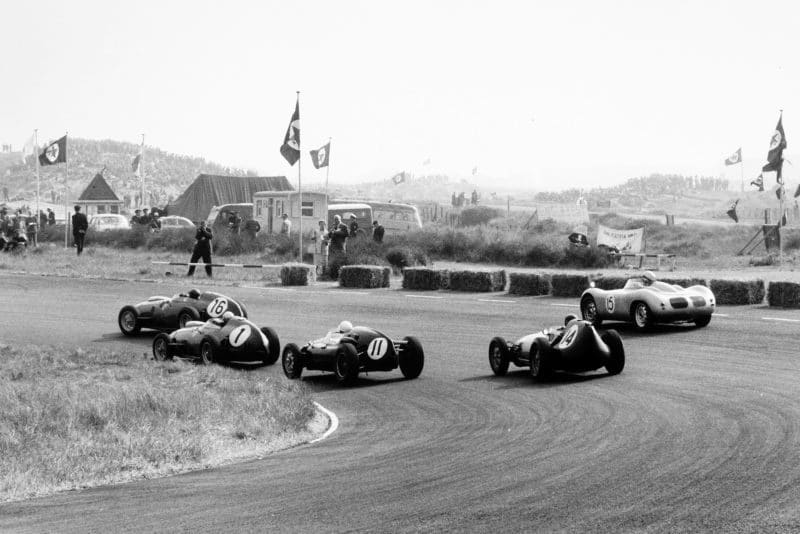
Cliff Allison in a Ferrari Dino 246, leads Jean Behra in his Ferrari Dino 246, Stirling Moss in a Cooper T51-Climax, Graham Hill in his Lotus 16-Climax, and Carel Godin de Beaufort in the Porsche RSK.
© LAT Photographic
There was nothing to choose between Gregory and Bonnier and they were drawing further and further away from the general run of the field, the Cooper always leading, but now Brabham was getting into his stride and leaving the pack behind and closing on the leaders. Moss was still badly hemmed in amongst the bunch that were scrapping for fourth place and though Schell was “elbowed” down a place per lap, first by Behra, then by Graham Hill and then by Moss, the space covering the eight cars in the bunch was not much changed. However, on lap eight Behra got past Brooks to lead the bunch and then Graham Hill and Moss got by and on lap 10 this almighty scrap broke up into three sections. Behra and Graham Hill and Moss pressing hard on his tail, Brooks and Schell were in close company and Phil Hill, Ireland and Trintignant were almost touching.
Gregory was still in the lead by a few feet and Brabham was only half the length of the straight behind, but on lap 12 Bonnier pipped the leading Cooper behind the pits, but then as he drew quickly away it was clear that Gregory was in trouble and sure enough the Cooper was jumping out of gear, as it had done in practice. Further back Brooks was also in trouble for an oil pipe union had split and his own oil mist was getting on his tyres and a viscous slide dropped back to 11th place, just able to hold on to the group comprising Phil Hill, Ireland and Trintignant.
Bonnier was holding a beautifully steady lead, but Brabham was closing rapidly on Gregory and on lap 15 the Australian driver took second place. Almost the whole length of the straight behind the third man came Graham Hill and Moss struggling in vain to get past Behra’s Ferrari, but the Frenchman had no intention of moving aside and letting them through. The Lotus was leaving the Cooper slightly out of some corners, but did not have enough acceleration to get past the Ferrari and on the straight it was all the Climax-engined cars could do to sit in the slipstream of the Italian car.
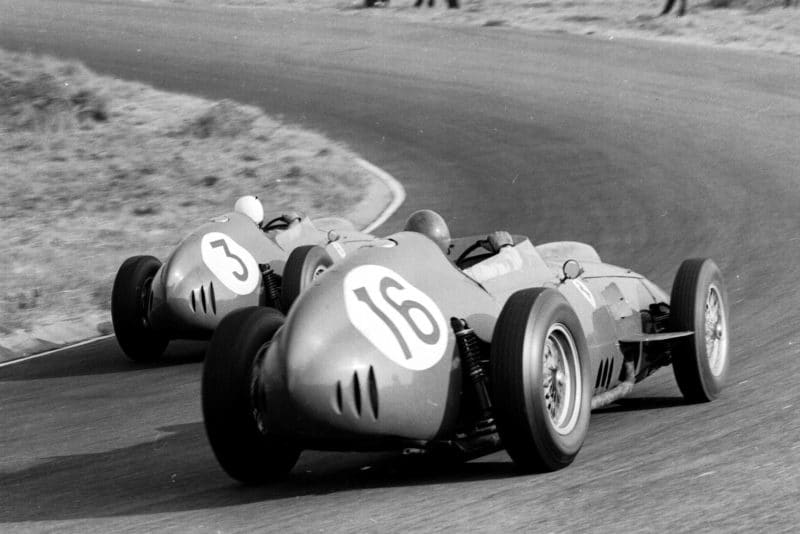
Phil Hill leads Cliff Allison, both driving Ferrari Dino 246’s.
© LAT Photographic
At the end of lap 15 they were all three practically touching, and then Hill let Moss go by to see if he could get past the Ferrari. All round the circuit Moss would get alongside the Ferrari, but never past it, and each time Hill would keep the Lotus right up the tail of the Cooper, alive to every opportunity for getting a tow through. At 20 laps Bonnier was holding a 3sec lead over Brabham and Gregory was now the whole finishing straight, or over half-a-mile behind them, while even further back Moss was shaking his fist at Behra, pulling up first on one side and then the other, always with the long thin Lotus a few feet behind; he even tried bumping the Ferrari up the tail with the nose of the Cooper, but Behra was not going to let the English cars by and on the straight they had not got the speed, and then, of course, Behra would give Moss an overtaking signal knowing full well he could do nothing about it.
“Moss was shaking his fist at Behra, pulling up first on one side and then the other; he even tried bumping the Ferrari up the tail with the nose of the Cooper”
For a moment it looked as though this battle was going to break up when Allison was about to lap de Beaufort’s Porsche when the high speed trio arrived to lap both of them, and there was a general mix up but when it cleared the order was still Behra, Moss, Hill. However, on lap 24 Moss was alongside Behra going into the Tarzan hairpin and in a very dicey manoeuvre he ran round the outside of the Ferrari and got by, and Behra was so taken aback that before the end of the lap Graham Hill had got by as well.
Moss now streaked away showing just how much he had been held up by the Ferrari and now had the difficult task of making up more than one-third of a lap on the leaders. Graham Hill’s lead over Behra was short-lived — for a puff of smoke came into the cockpit and thinking the Lotus was catching fire he stopped beside the track to investigate; there was nothing visibly wrong so he climbed back in and carried on, but had dropped back to 12th place, a lap behind the leader.
At 25 laps the field had spread out in the order Bonnier, Brabham, Gregory, Moss making up time fast, Behra, Schell, Ireland, Trintignant, Brooks still sliding on his own oil mist, Phil Hill and Shelby, the Aston Martin closing on the Ferrari, then Graham Hill a lap behind, with Allison and de Beaufort bringing up the rear, but the very next lap Shelby’s engine broke in a big way while rounding a very fast right-hand bend, and the Aston Martin locked up solid and spun down the track luckily without hitting anything.
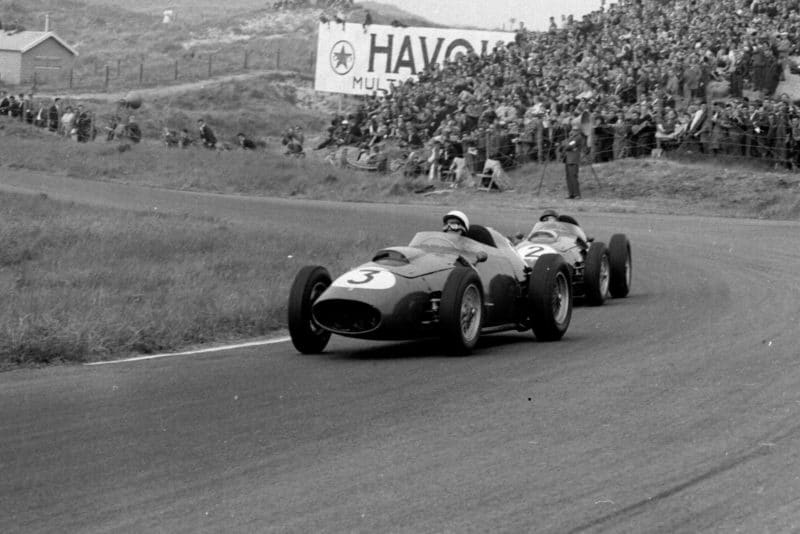
Phil Hill leads Tony Brooks, both driving Ferrari Dino 246s.
© LAT Photographic
Brabham was working very hard, and in spite of similar trouble to Gregory, with second gear jumping out he was closing on Bonnier, while Moss was closing relentlessly on both of them, driving in that fantastic way that only Moss can when roused. On lap 30 Brabham was right up with Bonnier and by a bit of dodgy braking at the end of the straight he carved his way in front of the BRM but Bonnier was not rattled and hung on to the Cooper, regaining the lead on lap 34 by a similar cutting-in movement going into the tight hairpin behind the pits.
Moss was now only 11sec behind and gaining each lap, having passed Gregory with ease and now Behra was tiring and Schell was trying to get by, which he eventually accomplished on lap 37 and shortly after that Ireland began to challenge Behra. At 40 laps Moss was only 8sec behind Bonnier, with Brabham still between them and with another 35 laps still to go victory seemed assured for the Walker-Cooper. Trintignant in the other Walker car was not very happy and stopped to check the throttle spring as it had seemed to have stuck slightly open, and at the same time he had the rear shock-absorbers adjusted as the car did not seem to be handling too well.
Bonnier and Brabham both lapped Phil Hill, and Graham Hill, who was closing on his namesake, then stopped at his pit to have the front-end inspected as the car was snaking badly under braking. There was nothing amiss with the chassis or suspension, but all the fluid had gone from the front brake system, which probably accounted for the puff of smoke earlier, and the back brakes only was causing the instability.
Hill went on but with no hope of getting anywhere and then Brooks stopped at the Ferrari pits and retired as the whole rear-end of the chassis was covered in oil mist, as were the rear tyres and the car was getting undriveable. Ireland was driving extremely well in his first big race and his Lotus was going perfectly, holding Behra with ease and worrying him on the corners, but not being able to get past.
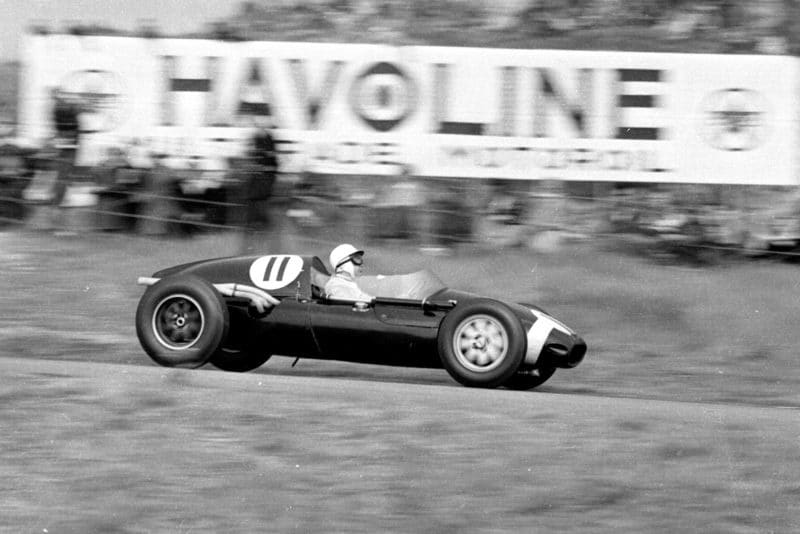
Stirling Moss in his Cooper T51 Climax.
© LAT Photographic
On lap 46 Moss was alongside Brabham, and still there on the next lap, the Australian not being beaten easily; Bonnier was given a tyre warning pit signal, but all was well and the oil and rubber coating on the track was easing the rate of wear as the race went on. On lap 49 Moss took second place by out-braking the works Cooper at the end of the straight and he then set about catching Bonnier, but the bearded Swede was still unrattled and was driving very smoothly, with the car running perfectly.
At 50 laps the order was Bonnier, Moss, Brabham all in close company, then Gregory a long way behind, and Behra with lreland still on his tail, the rest of the field comprising Phil Hill, Trintignant, Graham Hill, Allison and de Beaufort all having been well and truly lapped. Lap by lap, second by second, Moss closed on Bonnier and Brabham dropped back, his failing gearbox making the car more and more difficult to drive.
“Behra got a bit mad at being lapped by Moss, whom he had been racing against earlier and in trying to keep up he went sideways into a corner and slid off the road”
As the leader started his 60th lap Moss was on his tail and at the same time they came up behind Behra to lap him and in the general confusion Moss saw his chance and slipped into the lead. Behra got a bit mad at being lapped by Moss, whom he had been racing against earlier and in trying to keep up he went sideways into a corner and slid off the road, which allowed Ireland to go by; the Ferrari did not stop and Behra was soon back in the race, but now a long way behind and in fifth place.
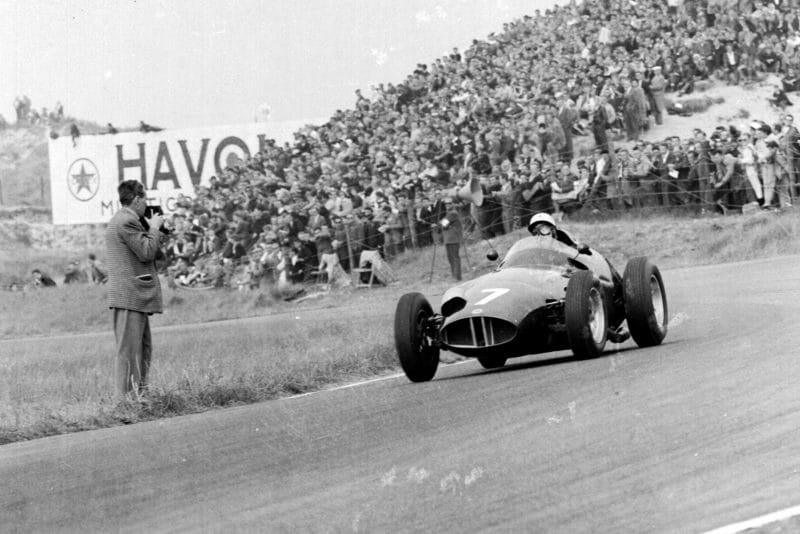
Jo Bonnier driving his BRM P25 to 1st position
© LAT Photographic
Having got the lead Moss soon drew away and Bonnier played safe and did not try to keep up, for Moss was at the top of his driving form. For three brief laps the dark blue Cooper led the race and then at the end of lap 63 it was the BRM which appeared first, followed by Brabham, and Moss was overdue; he appeared in third position going slowly and drew into the pits to retire, a ball race in the gearbox/final drive unit having broken up, and as at Monaco poor Moss had to watch someone else win a race that should have been his.
Bonnier was now securely in first place and the BRM pits hardly dare breathe as the car continued to reel off the laps, for already Schell had gone out with a seized gearbox, but the Swedish driver was more alive to the situation than anyone, and driving with perfect restraint and almost loving care for the car he completed the 75 laps amidst enormous enthusiasm, for if ever a team were due for a major victory, the BRM team were.
As Bonnier stopped after his lap of honour the BRM sounded as healthy as ever and it had run a perfect race, driven by a new Grand Prix winner who had handled the car and all the situations that arose with remarkable coolness. The two works Coopers followed in second and third positions, these three being the only ones to complete the full distance. At first the official results gave fastest lap to Bonnier, then it was changed to a tie between Bonnier, Brabham and Moss, and finally it was given to Moss, but even then the timekeepers had to make two stabs at the actual time. Fastest lap was a small consolation to the Walker team after being robbed of their second major victory by a mechanical failure.
Zandvoort Zidezlips
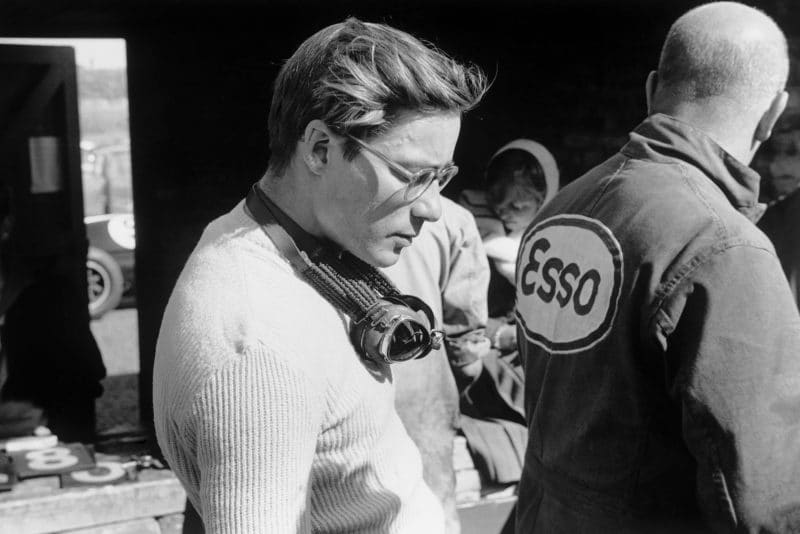
Masten Gregory who finished 3rd in his Cooper T51-Climax.
© LAT Photographic
- Shortly before the race the BRM team were given a “vote of no confidence” by Mr AG Owen when he handed over two cars to the Alfred Moss/Ken Gregory team known as the British Racing Partnership, having been convinced that they would do better than the Bourne people. After the Dutch GP one could not help feeling that Bourne had “cocked a snoot” at all concerned.
- Team Lotus showed a wonderful improvement with two cars starting and both finishing, one of them running non-stop. They also turned up with a delightful Transporter Special, comprising a lengthened Ford Thames truck fitted with a Zephyr engine.
- This year’s race was very similar to 1958 in that British cars were very much at home on the Zandvoort circuit and the Ferraris were hopeless.
- With the Aston Martin entry into GP racing another tyre firm appeared in the paddock, for the Feltham firm were using Avon tyres, as they have done on their sports cars for many years.
- No one seems quite sure as to what size Weber carburetters to use on the 2½-litre Coventry-Climax engine; Coopers experimented with 48 mm, 50mm and 58mm, Lotus used 50mm, and the Walker team 58mm.
- Is design stagnating or are we finding the complete answers to Grand Prix racing, for all F1 cars were using English disc brakes, English tyres and Italian carburetters?
